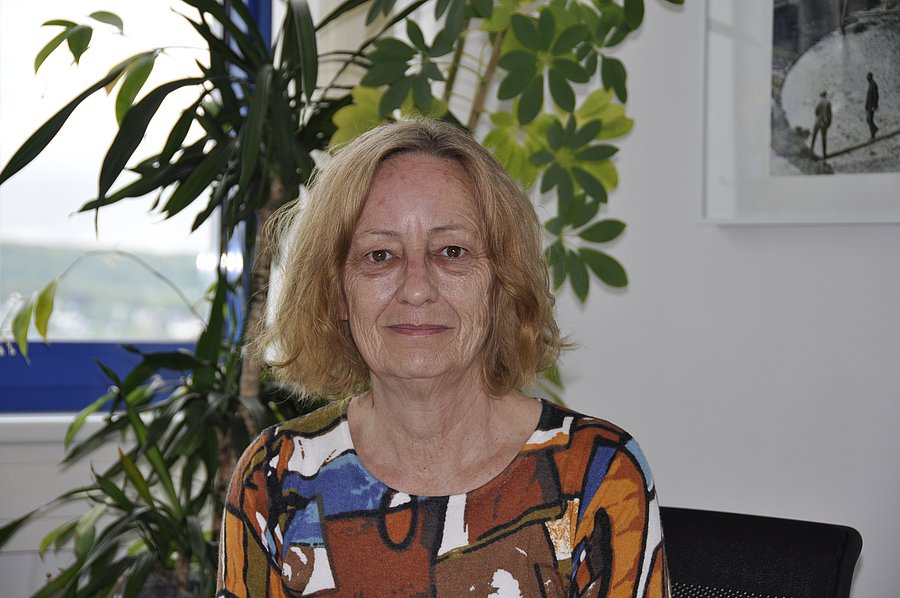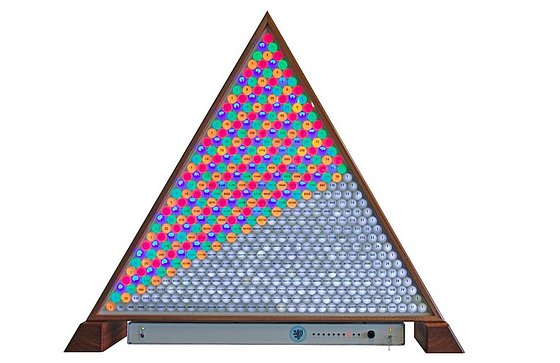
Pascal's Triangle
Prof. Dr. Margareta Heilmann / Mathematics
Photo: UniService Transfer
The sum of the upper right and left neighbours
Mathematician Margareta Heilmann on making and using Pascal's triangle at the Junior Uni
There is no reason to worry, if you have not heard of the Sierpinski triangle or cannot explain the recursive formation laws. These are mathematical phenomena that often only occupy an interested person during their studies. The mathematician Prof. Dr. Margareta Heilmann knows these and other formulas inside out. Just recently retired, she taught for no less than 25 years in the Faculty of Mathematics and Natural Sciences in the Optimisation and Approximation working group. One tries to approximate complicated mathematical objects, i.e. equations, functions or data, with simpler objects without losing essential information, in her research area of approximation theory, she explains. As a current example, she mentions the number of corona infections per day and their development, which is described with the term 'exponential growth'. "You then have the data, of how the numbers develop. And you try to put a suitable exponential function in such a way that the deviations from the actual numbers are as small as possible." The common 7-day incidence, with the upward or downward deviations in a certain period, can also be calculated with the functions of approximation.
The idea of creating the Pascal's triangle
Many years ago, Heilmann acquired an unusual book by the author Hans Magnus Enzensberger entitled 'Der Zahlenteufel' (The Number Devil). Not only she herself but also her son, who was just learning to read at the time, was enthusiastic about this book. "I had not thought about the fact that it might also interest my son. He saw the book, could just read and made me read it to him. And I thought, ' Well, if he gets bored, then we will stop,'" she laughs. "But it really fascinated him and especially the events that happen on the seventh night when the Number Devil presents this illuminated Pascal's Triangle to Robert, a boy who hates maths at school." In this book, the Number Devil then snaps his fingers and new patterns keep appearing on the model. The little hero in the book has to find the numbers that were visible in the previous nightsbefore. And Heilmann's son also created his own Pascal's triangle with Duplo and Lego bricks, on which he painted the numbers.Then, in 2008 came the Year of Science in Mathematics. Heilmann thought about her contribution to mark the occasion. "At some point I thought it would be great to build an illuminated Pascal's triangle," she says, "but I have absolutely no idea about electronic circuits and I could never have built and realised it. At this point, her colleague Hans-Josef Kulmer from Applied Mathematics comes into play, who implements her idea of the illuminated triangle. "He designed all these plans for the electronic circuitry and built this whole system. He also thought about what the LEDs had to be like and what material you need." Together with a student, they soldered circuit boards, which Kulmer then integrated. Thus, the Miracle Triangle could be handed over in time for the opening of the Junior Uni in the same year.

The Wuppertal Pascal Triangle
Created by Prof. Dr. Margareta Heilmann, Dipl.-Ing. Hans-Josef Kulmer, Jonas Kronenberg
The history of the triangle of numbers
The mathematician Blaise Pascal wrote the book "Traité du triangle arithmétique" (Treatise on the Arithmetical Triangle) in 1655. In it, he collected various results concerning the triangle and used them to solve problems in probability theory. Pascal's triangle is named after him."First of all, Pascal's triangle offers the possibility to represent certain numbers.", says Heilmann. "These are the so-called binomial coefficients, in a triangular form." The numbers that appear in it can thus be easily calculated. In principle, you can say that there are always all of the numbers 1 on the outside and everything in the middle is always calculated from the sum of the upper right and left neighbours. If there is a 1 on the right and a 2 on the left, then I add them together and get the 3, etc." The binomial formulae are still familiar to many people from school lessons. Remember: ( a + b )2 = a2 + 2ab + b2. Heilmann says: "Normally, you know the formula by heart. But if I now want to know what (a + b )27 is, it gets difficult and this Pascal's triangle helps me, since I get the solution from the triangle by taking the appropriate line.But the idea for this triangle is much older. There are similar models dating back to the 10th century Iin India and China. And a book on trade calculations from 1527 is the first European evidence.
How to decipher a secret code
According to Heilmann, one can do a thousand things with Pascal's triangle, including determining the Fibonacci numbers. Thriller readers and moviegoers still know these from the Dan Brown thriller "The Da Vinci Code", in which they function as a secret message. Heilmann knows how to do it. "There is a passage where eight numbers are listed, but in some order tn the book by Dan Brown. I looked it up and it is 13, 3, 2, 21, 1, 1, 8, 5. If someone who does not know anything about it looks at it, they will not know what to do with it. But I guess that every mathematician can relatively quickly see that these Fibonacci numbers are hidden in it." While this is not the correct order of the Fibonacci numbers, this again has meaning in the context of the novel. "This is considered as a clue in the book. You have to put the letters of the text that is underneath in a different order so that a meaningful clue comes out. If you put the above numbers in a meaningful order, then you get the first eight numbers of the Fibonacci sequence. And if you then put these letters in the right order, you get 'Leonardo da Vinci the Mona Lisa'. That is the clue to further follow the trail in the book."Furthermore, the Fibonacci numbers can be found in many places in art and nature.
Colourful patterns through prime numbers
What makes the Wuppertal Triangle so special? "It looks great," says Heilmann enthusiastically. "The lighting is fascinating. Very specific numbers are red and others are white. You may ask yourself, what they have in common?" Particularly beautiful patterns emerge when you illuminate numbers that are divisible by prime numbers and the children find what they have in common. If you illuminate the odd numbers, you create triangles whose sides you halve to create smaller triangles. You then illustrate the Sierpinski triangle mentioned at the beginning. School mathematics is a horror for many children. The book 'Der Zahlenteufel' (The Number Devil) is a wonderful introduction since the author explains it in a plausible and playful way. Enzensberger also shows, that sometimes different questions lead to the same solutions. The book offers a wealth of suggestions that can get children excited about mathematics. "And that is the essence of mathematics," Heilmann states, "this level of abstraction."
Costly repair
After 13 years of use at the Junior Uni, Wuppertal's Pascal's Triangle has returned to the University of Wuppertal and is awaiting its costly repair. Heilmann is personally taking care of it, making appointments and hoping for the miracle to soon be back in use at the Loh. "You have to have fun figuring that out with the kids," she concludes, because "anything that is fun does not make you think about working or learning at all."
Uwe Blass (Interview on July 12, 2021)
Prof. Dr. Margarete Heilmann taught in the Faculty of Mathematics and Natural Sciences in the Optimisation and Approximation working group from 1996 to 2021 and is the originator of the Wuppertal model of Pascal's triangle.
